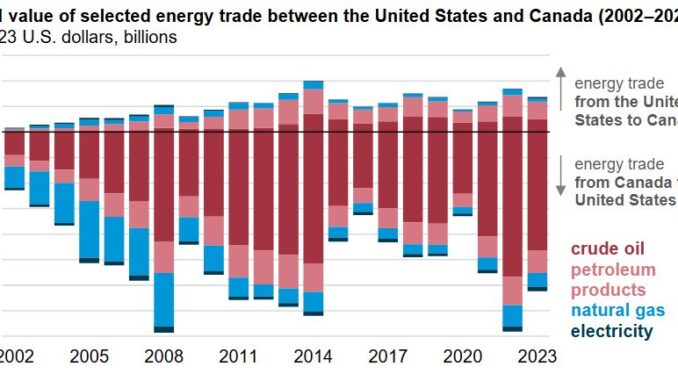
The value of energy trade between the United States and Canada decreased in 2023 from the record set in 2022 as energy prices fell, according to data from the U.S. Census Bureau. Although the amount of energy traded between the two countries was largely flat in 2023, the value decreased by 20% when adjusted for inflation to $152 billion.
Energy trade value is the combined value of energy imports and exports between two countries. Trade value is driven by both commodity prices and the commodity volumes imported and exported. The value of U.S. imports from Canada in 2023 totaled $125 billion, much more than U.S. exports to Canada of $27 billion.
Crude oil. U.S. crude oil imports from Canada in 2023 averaged 3.9 million barrels per day (b/d), 2% more than in 2022. The value of U.S. imports of crude oil from Canada decreased 18% in 2023 to $93 billion because of the drop in the average price of crude oil. The Brent crude oil price fell to $82/b in 2023 from $101/b in 2022. Canada is a key source of U.S. crude oil imports, accounting for 60% of all crude oil imported into the United States in 2023. U.S crude oil exports to Canada are small by comparison, averaging 339,000 b/d in 2023, a slight increase from 2022. By value, U.S. crude oil exports to Canada decreased by 15% in 2023, totaling $10 billion.
U.S. crude oil exports to Canada are typically made up of low-density and low-sulfur crude oil grades shipped to Eastern Canada and make up only 8% of all U.S. crude oil export volumes, which reached a record in 2023. U.S. crude oil imported from Canada tends to be high-sulfur crude oil from oil sands in Western Canada, most of which is shipped to Midwestern and Gulf Coast U.S. refineries.
Historically, exports from Canada’s key producing area in the West of the country have been limited mostly to the United States, comprising 80% of Canada’s total oil production in 2023. As a result, U.S. refineries have been able to capitalize on discounted Canadian crude oil volumes from Alberta. However, the recent startup of the Trans Mountain Pipeline expansion nearly tripled the crude oil produced in Alberta to be sent to Burnaby, a port in British Columbia with access to global oil tankers. The completion of the expansion is likely to shift some future crude oil volumes away from the United States and to new export markets.
Petroleum products. Petroleum product trade between the United States and Canada decreased by about 6% by volume in 2023 and by about 19% by value, driven in part by more domestic motor gasoline supplies in Canada. The United States imported 549,000 b/d of petroleum products from Canada, a 3% decrease. The combination of lower fuel prices and smaller volumes led to an 18%, or $4 billion, decrease in the value of petroleum imports from Canada. Meanwhile, U.S. petroleum product exports to Canada in 2023 averaged 460,000 b/d, 10% less than in 2022. Similarly, the value of U.S. petroleum product exports to Canada in 2023 was 20% less than in 2022.
Natural gas. The value of natural gas trade fell significantly due to multiyear low natural gas prices in 2023. Natural gas imports from Canada in 2023 averaged 8.0 billion cubic feet per day (Bcf/d), 3% lower than in 2022, while the value of these imports was 36% lower in 2023. Despite a 7% increase in the volume of natural gas exports to Canada, which averaged 2.8 Bcf/d, the value fell by nearly half, totaling $2 billion in 2023.
Electricity. Electricity trade between the two countries is small compared with trade in other energy sources. The value of electricity trade between the United States and Canada totaled $5 billion in 2023, most of which was electricity imported from Canada into the United States. The value of imported electricity from Canada into the United States fell by 19% in 2023 but accounted for 74% of the total electricity traded between the two countries.







